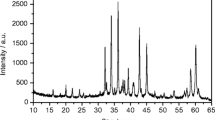Abstract
Neutron irradiation and post-irradiation annealing under oxidising and reducing conditions have been used to investigate H incorporation in, and the optical properties of, reduced (TiO2−x ) rutile. Optical absorption in rutile is mainly due to a Ti3+ Ti4+ intervalence charge transfer effect. The main mechanism for H incorporation in rutile involves interstitial H not coupled to other defects, which has important implications for the rate of H diffusion, and possibly also on the electrical properties of rutile. Additional minor OH absorption bands in IR spectra indicate that a small amount of interstitial H is coupled to defects such as Ti3+ on the main octahedral site, and indicates that more than one H incorporation mechanism may operate. Concentration of oxygen vacancies has a controlling influence on the H affinity of rutile.






Similar content being viewed by others
References
Aono M, Hasiguti R (1993) Interaction and ordering of lattice defects in oxygen-deficient rutile TiO2−x. Phys Rev B 48(17):12406–12414
van der Berg A, Gora L, Jansen J, Maschmeyer T (2003) Improvement of zeolite NaA nucleation sites on (001) rutile by means of UV radiation. Microporous Mesoporous Materials 66:303–309
Bromiley GD, Keppler H (2004) An experimental investigation of hydroxyl solubility in jadeite and Na-rich pyroxenes. Contrib Mineral Petrol 147:189–200
Bromiley GD, Hilaret N (2005) An investigation of hydrogen and minor element incorporation in synthetic rutile. Mineral Mag 69(3):345–358
Bromiley GD, Hilaret N, McCammon C (2004a) Solubility of hydrogen and ferric iron in rutile and TiO2 (II): Implications for phase assemblages during ultrahigh-pressure metamorphism and for the stability of silica polymorphs in the lower mantle. Geophys Res Lett 31:L04610
Bromiley GD, Keppler H, McCammon C, Bromiley F, Jacobsen S (2004b) Hydrogen solubility and speciation in natural, gem-quality chromian diopside. Am Mineral 89:941–949
Buck EC (1995) The effects of electron irradiation of rutile. Rad Effects Defects Solids 133(2):141–152
Catlow C, James R, Mackrodt W, Stewart R (1982) Defect energies in α-Al2O3 and rutile TiO2. Phys Rev B 25(2):1006–1026
Diebold U (2003) The surface science of titanium dioxide. Surf Sci Rep 48(4–5):53–229
Gonzalez R, Chen Y (2002) Transport of hydrogenic species in crystalline oxides: radiation and electric-field-enhanced diffusion. J Phys Condensed Matter 14(45):R1143–R1173
Hammer V, Beran A (1991) Variations in the OH concentrations of rutile from different geological environments. Mineral Petrol 45:1–9
Henderson M (1999) A surface perspective on self-diffusion in rutile TiO2. Surf Sci 419:174–187
Kappers LO (1978) Point defects in particle-irradiated single crystals of tetragonal GeO2. Phys Rev B 17:4199–4206
Katayama I, Hirose K, Yurimoto H, Nakashima S (2003) Water solubility in majoritic garnet in subducting oceanic crust. Geophys Res Lett 30(22):2155
Khomenko V, Langer K, Rager H, Fett A (1998) Electronic absorption by Ti3+ ions and electronic delocalization in synthetic blue rutile. Phys Chem Mineral 25:338–346
Kingsbury PW, Ohlsen W, Johnson OW (1968) Defects in rutile III. Diffusion of interstitial ions. Phy Rev B 175:1099–1101
Kohn S, Brooker R, Frost D, Slesinger A, Wood B (2002) Ordering of hydroxyl defects in hydrous wadsleyite (beta-Mg2SiO4). Am Mineral 87(2–3):293–301
Koudriachova M, de Leeuw S, Harrison N (2004) First-principles study of H intercalation in rutile TiO2. Phys Rev B 70:165421
Kröger FA, Vink HJ (1956) Relations between the concentrations of imperfections in crystalline solids. In: Seitz F, Turnball D (eds) Solid state physics: advances and applications, vol 3. Academic, New York, pp 307–435
Lager G, von Dreele R (1996) Neutron powder diffraction study of hydrogarnet to 9.0 GPa. Am Mineral 81(9–10):1097–1104
Lehman C (1977) Interaction of radiation with solids and elementary defect production. In: Defects in crystalline solids, vol 10. North Holland Publishing Company, Amsterdam, 341 pp
Lu T-C, Wu S-Y, Lin L-B, Zheng W-C (2001) Defects in the reduced rutile single crystal. Physica B 304:147–151
Lu T-C, Lin L-B, Wu S-Y, Chen J, Zhang Y-Y (2002a) Influence of neutron irradiation and its post-annealing on optical absorption of rutile. Nucl Instrum Methods Phys Res B 191:236–240
Lu T-C, Lin L-B, Wu S-Y, Xu X-C, Cheng G (2002b) Influence of proton implantation on optical absorption of rutile. Surf Coatings Technol 158–159:431–435
Moore D, Cherniak D, Watson E (1998) Oxygen diffusion in rutile from 750 to 1,000°C and 0.1 to 1,000 MPa. Am Mineral 83:700–711
Schmidt BC, Holtz FM, Bény J-M (1998) Incorporation of H2 in vitreous silica, qualitative and quantitative determination from Raman and infrared spectroscopy. J Non-Crystalline Solids 240:91–103
Swope R, Smyth J, Larson A (1995) H in rutile compounds: I. Single-crystal neutron and X-ray diffraction study of H in rutile. Am Mineral 80:448–453
Thomas BS, Marks NA, Corrales LR, Devanathan R (2005) Threshold displacement energies in rutile TiO2: a molecular dynamics simulation study. Nucl Instrum Methods Phys Res B 239(3):191–201
Traylor J, Smith H, Nicklow R, Wilkinson M (1971) Lattice dynamics of rutile. Phys Rev B 3(10):3457–3472
Zapunnyy S, Sobolev A, Bogdanov A, Slutsky A, Dmitriev L, Kunin L (1989) An apparatus for high-temperature optical research with controlled oxygen fugacity. Geochim Int 26(2):120–128
Acknowledgements
This work was funded by the Bayersiches Geoinstitut visiting scientists program (to GDB) and by Alexander von Humboldt foundation (to AAS). The authors thank Dr. N. N. Dogadkin (Vernadsky Institute of Geochemistry) for performing neutron irradiation experiments. Hans Keppler is thanked for useful comments regarding H2 measurements. Comments by two anonymous reviewers greatly improved the quality of this paper.
Author information
Authors and Affiliations
Corresponding author
Rights and permissions
About this article
Cite this article
Bromiley, G.D., Shiryaev, A.A. Neutron irradiation and post-irradiation annealing of rutile (TiO2−x ): effect on hydrogen incorporation and optical absorption. Phys Chem Minerals 33, 426–434 (2006). https://doi.org/10.1007/s00269-006-0087-9
Received:
Accepted:
Published:
Issue Date:
DOI: https://doi.org/10.1007/s00269-006-0087-9



